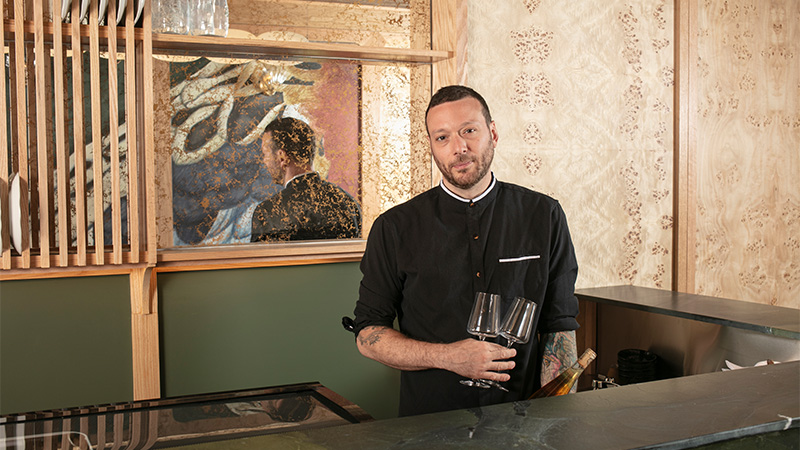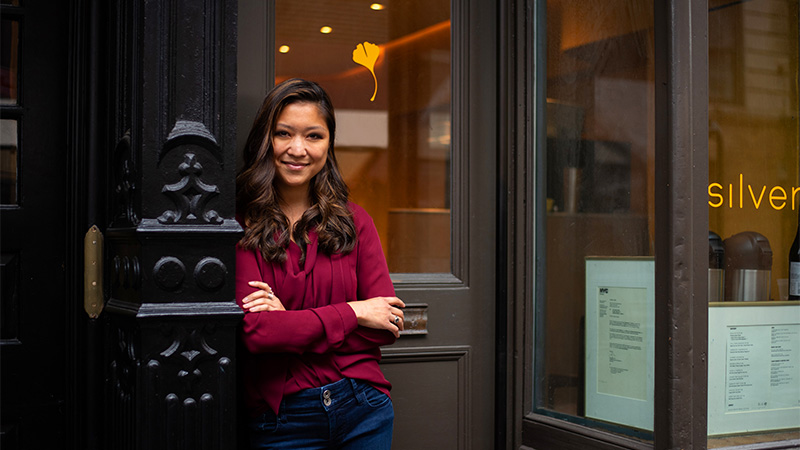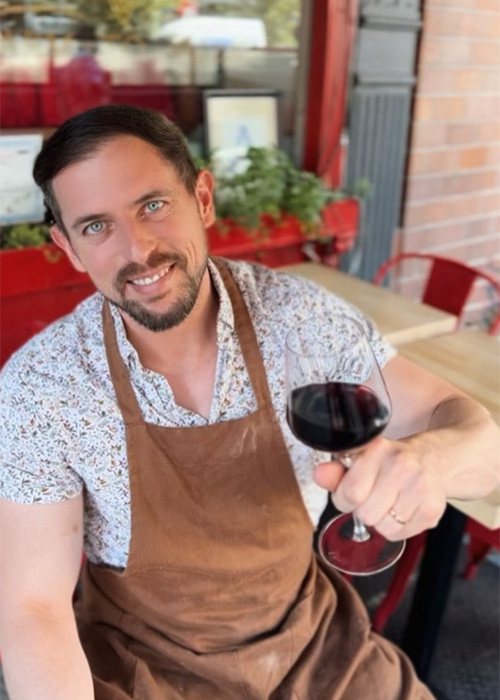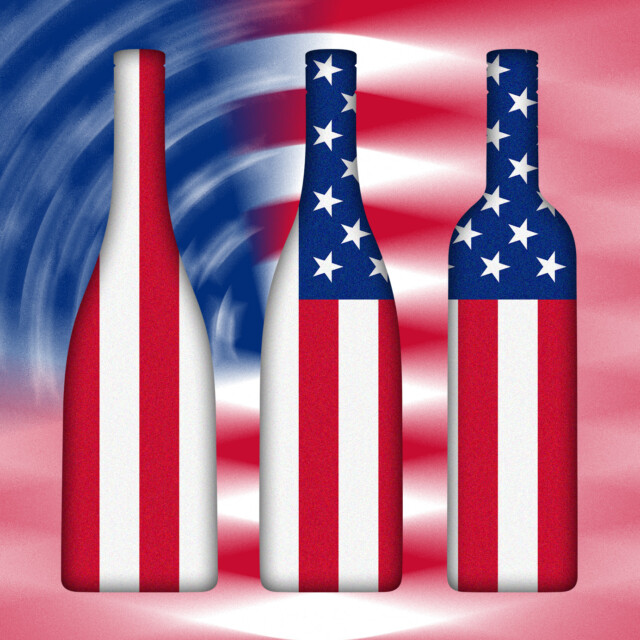For some, ordering a round of Champagne or a bottle of Chianti is a dining reflex. But what happens if there’s no French or Italian wine to be found on the menu? Can a sparkling wine from Seneca Lake or a Sangiovese from Mendocino fill the gap?
As America’s wine culture expands, more restaurants are experimenting with completely domestic wine programs. And while Burgundy snobs and Barolo enthusiasts may turn their noses up at the idea, many factors suggest now might be the best time to embrace local wine.
One of the most pressing issues is sustainability. Beyond the push for organic farming and mindful energy consumption at wineries, there’s a growing concern over the carbon footprint caused by transporting wine in heavy glass bottles. The vessels make overseas shipping carbon-intensive, and in response many producers have shifted to using lighter glass, cans, or even boxes. But another — possibly more effective — solution to reduce wine’s carbon footprint is to source exclusively from nearby wineries.
Coinciding with this cry for sustainability, the U.S. wine industry is rapidly growing in both size and diversity. It’s not all jammy Napa Cab and over-oaked Chardonnay. There’s spicy Cabernet Franc from the California coast, juicy Gamay from Oregon, bone-dry Finger Lakes Riesling — the list goes on.
The reasons for switching to all-domestic lists make the concept a no-brainer. But is it financially viable and will consumers buy into it?
Holistic Thinking
In the late ‘90s and early aughts, the slow food movement spawned a flurry of farm-to-table restaurants across the U.S. The obsession with knowing every small detail about the origins of produce became so pervasive that it was even reduced down to a Portlandia skit. Though restaurants successfully championed this idea on the food side, beverage directors haven’t followed chefs’ leads, and continue to pour global wines alongside the local menus.
One restaurant that challenges the status quo is The Marshal in New York City’s Hell’s Kitchen neighborhood. Chef Charlie Marshall opened the concept 10 years ago with sustainability top of mind. Not only are the ingredients locally sourced and the ovens fueled with wood from nearby orchards, The Marshal also pours wines exclusively from New York State. “If you’re going to call yourself a farm-to-table restaurant, you should be sourcing a lot of your wines locally,” Marshall says.
Similarly, East Village restaurant Rosella serves sushi and creative Japanese-inspired dishes using North American-sourced seafood. Patrons might find themselves enjoying bluefin tuna sashimi from Nova Scotia, farro miso soup with Pennsylvania-made miso, and even soy sauce from Connecticut.
After starting his hospitality career at the New York winery, Brooklyn Oenology, it was particularly important to partner TJ Provenzano that the beverage list reflected the values of the cuisine, so all the wines served at Rosella are domestically sourced.

Partners Jeff Miller and Provenzano continue to push boundaries with their latest project, an eight-seat tasting counter called Bar Miller. While it’s commonplace in New York to overnight fish from Japan, Bar Miller has curated an entirely local 15-course omakase menu. The beverage pairing is also singularly focused on New York, with skin-contact Long Island wines, Hudson Valley pét-nats, cider from Niagara Falls, and Brooklyn-made sake.
“As much as we should celebrate wines grown on our home turf, we must understand that we are light years behind Europe in terms of our alcohol policies and distribution structure.”
Further downtown, at the Chinese-American restaurant Silver Apricot, managing partner and sommelier Emmeline Zhao also takes a holistic approach to the food and beverage selections. “Silver Apricot’s menu is meant to celebrate an entire generation of Chinese Americans who were born to immigrants, and if that’s what the food was going to be about, the beverage program is the other half of the story,” Zhao says. “Immigrants from traditional winemaking regions come to make wine in the U.S. because there’s room to innovate.”
By offering an entirely domestic list of wine, sake, and beer — with many products crafted by immigrants, first-generation Americans, and women — Zhao aims to further convey Silver Apricot’s message of immigration and ingenuity.

Post-Prohibition Woes
Even though some businesses have had success with the domestic model, industry skeptics could rightfully point to a number of hurdles holding them back. A slew of outdated, state-specific regulations often make it more difficult for restaurants to buy wines from a neighboring state than sourcing bottles from Europe.
“As much as we should celebrate wines grown on our home turf, we must understand that we are light years behind Europe in terms of our alcohol policies and distribution structure,” Vincent Morrow, wine director at Press in Napa Valley, says. “Not all restaurants are going to have access to the small to medium-sized producers that could bring greater quality and diversity to their list, either because the state laws are prohibitive for that winery to do business in or the distributor in that particular state doesn’t carry SKUs under certain case production.”
“When you can choose from a world of wines, you can get those really cheap bottles that still show well, and this can be very profitable for the restaurant.”
Even though the wine list at Press is 90 percent from Napa Valley, Morrow believes that the decision to focus on domestic wines should depend on the restaurant’s location and demographic of guests. “I think restaurants should support domestic wine, but not do so at a detriment to their business and who they’re serving,” he says.
In New York, Marshall shares that while it’s relatively easy for restaurants to buy wine from within the state, it’s nearly impossible to purchase bottles from neighboring regions in New Jersey, Maryland, and Virginia. New York winemakers that produce under 250,000 gallons of wine annually can sell directly to restaurants under a Farm Winery License.

But for surrounding areas to get bottles across state lines they need to be carried through a distributor in that specific state, which is a large hurdle for smaller wineries. So while New York restaurants have a plethora of options as the third-largest wine-producing state in the U.S., other areas are often out of luck when it comes to accessing America’s treasure trove of up-and-coming producers.
Furthermore, the U.S. doesn’t have as many options as Europe when it comes to good-quality bargain bottles that offer big margins on by-the-glass lists. “When you can choose from a world of wines, you can get those really cheap bottles that still show well, and this can be very profitable for the restaurant,” Marshall says. “Those kinds of deals or finds aren’t really present in the [domestic] market.”
Even so, some restaurants have found a compromise that allows them to minimize their environmental impact while also staying on budget. Woodford Food & Beverage in Portland, Maine, opened in 2016 with the goal of embodying the quintessential American brasserie with a sustainable edge. The restaurant’s by-the-glass pours come from around the world, but are sourced from sustainable producers and mindfully transported. Many arrive from Europe in large vats or kegs rather than heavy glass bottles. Additionally, the restaurant’s bottle list is solely domestic, featuring both classic and emerging producers.
All About Education
As with almost everything in wine, education is a key part of this puzzle and restaurants have one of the best platforms to provide it. Sommeliers have the opportunity to share America’s most exciting producers directly with their guests, and the power to win over even the most stubborn Euro-centric drinkers.
“We’ve always gotten a little bit of pushback from guests, but we have to remind them we’re doing something specific here,” Provenzano says. “None of the fish is from Japan, so it just feels ridiculous for us to bring in wines from across the world.”
To sell New York wines to skeptics, Provenzano uses the element of surprise. He trains the staff to talk about the characteristics of a wine, pour the customer a taste, and discuss why they like it, and then reveal where it’s from. “This way we don’t let them be inhibited by any preconceived notions.” Zhao also encounters doubters at Silver Apricot, and puts the sommelier tradition of blind tasting to good use in such instances, pouring examples from the U.S. next to wines from France.
But it’s not just convincing patrons that U.S. wines can be excellent, even though that’s half the battle. It’s also conveying how supporting local producers has the added benefit of being more eco-friendly.
“Someday, if you’re served a wine that’s coming from Chile or Spain, are people going to turn up their nose the same way as when they hear that Harry and Megan fly private instead of commercial?” Marshall says. “I think that attitude is changing.”
This story is a part of VP Pro, our free platform and newsletter for drinks industry professionals, covering wine, beer, liquor, and beyond. Sign up for VP Pro now!
